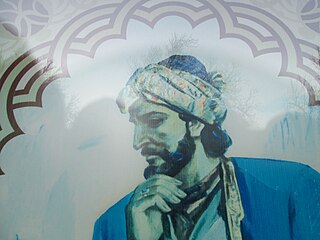
Jalāl al-Dawla Mu'izz al-Dunyā Wa'l-Din Abu'l-Fatḥ ibn Alp Arslān, better known by his regnal name of Malik-Shah I, was Sultan of the Seljuq Empire from 1072 to 1092.

Khāqāni or Khāghāni, was a Persian poet. He was born in the historical region known as Shirvan, under the Shirvanshah and died in Tabriz, Iran.

The Pir Huseyn Khanqah and Mausoleum lies along the left bank of Pirsaat River (Pirsaatçay), 126 kilometers to the southwest of Baku. The inscription plaque over the portal, read by V. Kratchkovskaya in 1952, announces that the khanqah was built by Sharaf al-Dawla wal-din Hasan during the reign of the Shirvanshah Afridhun Abul-Muzaffar Fariburz. The title gives a later date: "Here lies the sheikh, imam, mystic...Al-Husain, son of 'Ali, known as Pir Husain Rawanan...His tomb was rebuilt by 'Umar, son of Muhammad al-Shirzadi of Qazvin and completed in the year of 684 [1280 B.C.E.]." It is likely that the tomb of Pir Husayn bin Ali, an Azeri sheikh of the Qalandari sect who lived in the 11th century, existed on this site before a formal khanqah was built around it in the 13th century.
Masud ibn Namdar was a Kurdish collector of local documents who wrote some forty years after the fall of Shaddadids of Ganja. He was the author of collection of documents relating to the area of Arran. His records, compiled about 1111, discuss the revolt of Askuya against his father Fadl as well as other current events. Also from the correspondence collected by him, it seems that Ganja was temporarily occupied by the Shirvanshah Fariburz. Overall, his records provide important information on the history of the Caucasus and are used by historians to sketch the events of his time.

Shirvanshah, also spelled as Shīrwān Shāh or Sharwān Shāh, was the title of the rulers of Shirvan, located in modern Azerbaijan, from the mid-9th century to the early 16th century. The title remained in a single family, the Yazidids, an originally Arab but gradually Persianized dynasty, although the later Shirvanshahs are also known as the Kasranids or Kaqanids. The Shirvanshah established a native state in Shirvan.
Qutqashen Sultanate also known as Qabala mahaly was feudal state which existed from the middle to the end of 18th century in the north of Azerbaijan, in the territories covering the present day Qabala Rayon.
Sabayil Castle is a castle in Baku, Azerbaijan, on the coast of the Caspian Sea.

Yazid ibn Ahmad or Yazid II was the tenth independent Shah of Shirvan.

Fariburz ibn Sallar, better simply known as Fariburz I (فریبرز), was the sixteenth Shah of Shirvan, ruling from 1063 to 1096. His reign saw many major political balance changes in Caucasus, including expansion by the Seljuqs. He was considered a ruler with great diplomatic skills, and his kingdom extended from Mughan to Kumuk and Alania.
Afridun the Martyr was the eighteenth Shah of Shirvan. He was appointed governor of Derbent several times during his father's reign.
Shirvanshah Manuchehr III The Great was the nineteenth independent Shah of Shirvan.
Shirvanshah Afridun II the Lionheart was the twentieth independent Shah of Shirvan.
Farrukhzad I was the 24th ruler of Shirvanshahs. He was fourth son of Shirvanshah Manuchehr III, younger brother of previous shahs - Shirvanshah Afridun II, Akhsitan I, Shirvanshah Shahanshah, uncle of Shirvanshah Fariburz II and father of Shirvanshah Gushtasb I and Prince Rashid ibn Farrukhzad.

Fariburz was the 26th Shirvanshah. He defeated his father and become shah with support of local people.
Akhsitan III was the 29th ruler of Shirvan, now part of Azerbaijan. He was the son of Shirvanshah Farrukhzad II.
Kavus was the 32nd ruler of Shirvan. He was a son of Shirvanshah Keykubad I and older brother of Prince Sultan Muhammad.
Farrukh Yassar II was the 42nd shah of Shirvan.
House of Derbent — was a younger branch of Shirvanshahs.
The Kasranids were a branch of the Shirvanshahs, who ruled the Shirvan region of the Caucasus for 387 years. The word "Kasra" was derived from legendary king Kai Khosrow of Iran, reflecting a shift in naming tradition from Arabic to Persian. The Kasranids name was part of an effort to break with their Arabic roots by claiming to be successors of the Sassanids and the Kayanian dynasty.
Fariborz is an Iranian hero in Shahnameh, the national epic, of Greater Iran. He is son of Kay Kavus and brother of Siyâvash. He appears in the story of Mazandaran, the story of Sohrab and the story of Siavash. But his most important role is when Giv brings Kay Khosrow back to Iran. Tous, another Iranian hero is opposed to the rulership of Kay Khosrow in favor of Fariburz, because Kay Khosrow is grandson of Afrasiab. Kay Kavus, unable to choose between Kay Khosrow and Fariburz, decides to give the rulership to the one who can successfully captures a fortress in Ardabil. Tous and Fariburz are unable to take the fortress, while Giv and Kay Khosrow are able to take it easily. Kay Khosrow thus becomes the king of Iran. Fariburz thereafter obeys Kay Khosrow and participates in the wars between Iran and Turan. Fariburz married Farangis, Kay Khosrow's mother. Fariburz is among those heroes that disappear in the snow after Kay Khosrow's ascend.








